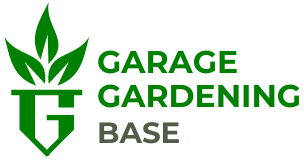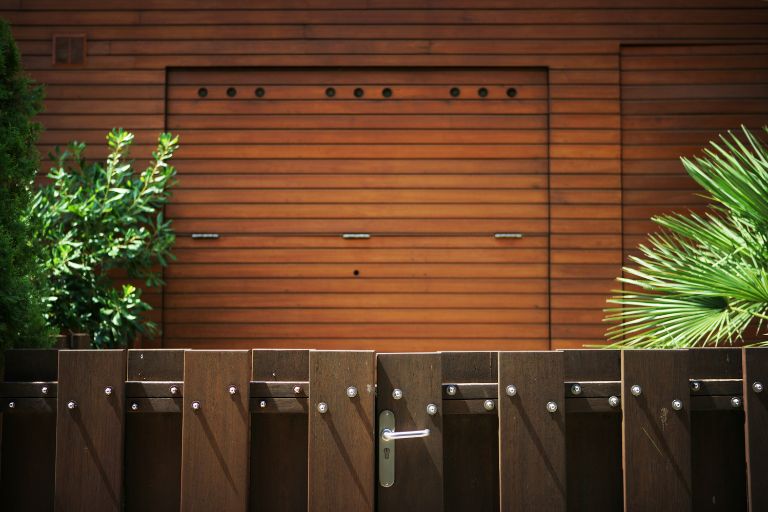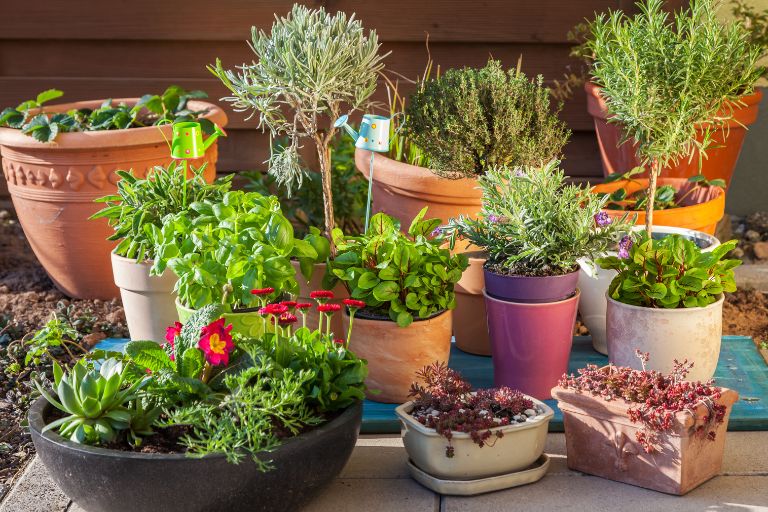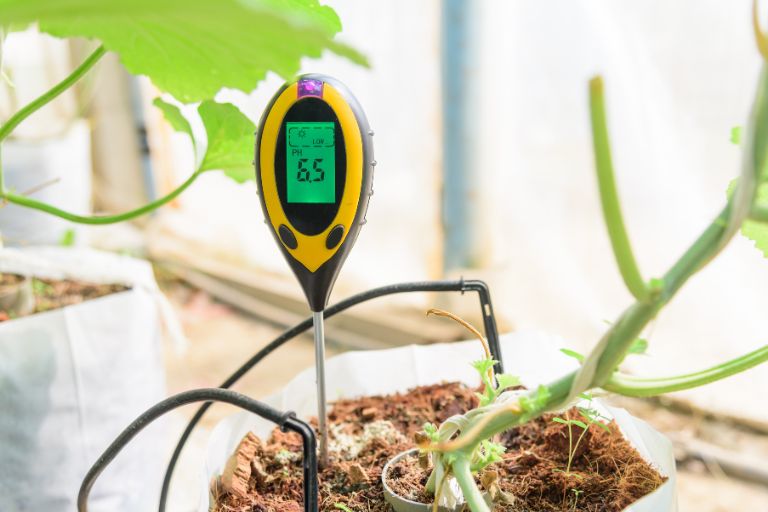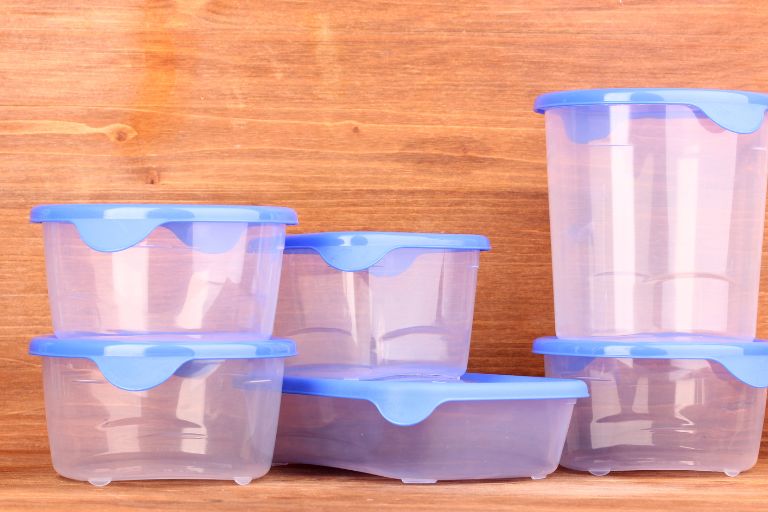A Guide to Growing Berries in Containers in Your Garage
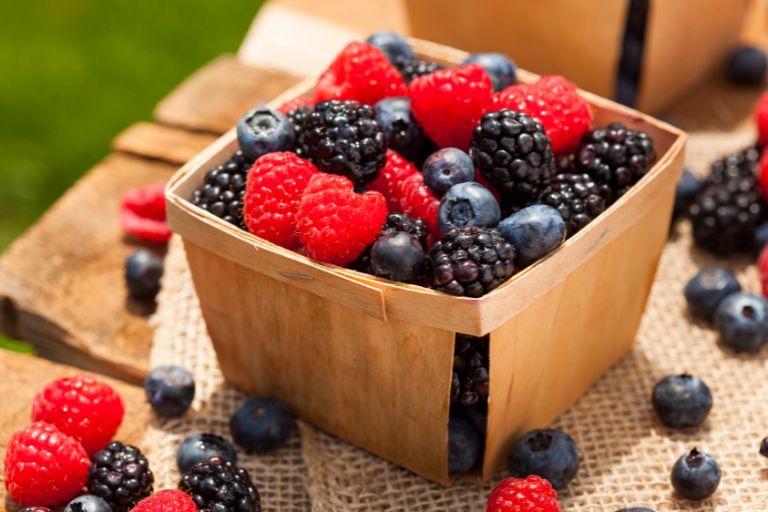
In the world of gardening, the desire to grow fresh produce is often met with challenges, especially for those with limited outdoor space or living in regions with harsh climates. Yet the allure of home-grown berries, with their vibrant colours and sweet flavours, remains a tantalising prospect for many. Enter the innovative solution: growing berries in containers within the confines of your garage.
While the garage is traditionally a place to store tools, vehicles and miscellaneous items, it holds untapped potential as a sanctuary for cultivating nature’s bounty. In this article, we embark on a journey to unlock the secrets of maximising space and harnessing the power of container gardening to create a thriving berry patch right in the heart of your home.
From choosing the perfect varieties and containers to optimising light levels and managing temperature and humidity, we delve into the intricacies of growing berries indoors. By the end of this guide, you’ll be equipped with the knowledge and tools you need to transform your garage into a thriving, berry-filled oasis, proving that even the most unconventional spaces can be fruitful.
Choosing the Right Berries
When it comes to selecting berry varieties for container growing in the garage, it’s important to explore a wide range of options to find the best fit for your specific environment and preferences. Each berry variety comes with its own set of requirements and considerations, including space needs, light requirements and climate adaptability. We’ll take a closer look at some of the top choices for growing in the greenhouse, providing a comprehensive insight into their characteristics and suitability for container growing:
Strawberries (Fragaria spp.)
Space requirements – One of the most popular choices for container gardening, strawberries are known for their compact and low-growing habit, making them perfect for containers with limited space. They can thrive in hanging baskets, vertical planters or traditional pots.
Light requirements – Strawberries prefer full sun but can tolerate partial shade, making them adaptable to garage environments with adequate natural or artificial light. Positioning containers near windows or under grow lights can ensure adequate light.
Climate adaptability – Many strawberry varieties are versatile and can adapt to a wide range of climates. However, they may need protection from extreme heat or cold if grown in an uncontrolled garage environment.
Blueberries (Vaccinium spp.)
Space requirements – Although blueberries are shrubby plants that can grow quite large, selecting dwarf or patio varieties is key to successful container growing in the garage. Choose pots or containers that allow enough space for root development and growth.
Light requirements – Blueberries thrive in full sun but can tolerate partial shade, making them suitable for well-lit garage environments. Adequate lighting is essential for fruit production, so supplementing with grow lights may be necessary, especially during the winter months.
Climate adaptability – Blueberries have specific soil and pH requirements, but some varieties are more adaptable to container growing and can be grown indoors with proper care. Ensure proper insulation and temperature control to mimic their preferred growing conditions.
Raspberries (Rubus spp.)
Space requirements – Raspberries can be grown in containers, but may require larger pots or containers due to their spreading habit. Consider selecting compact or dwarf raspberry varieties for easier management.
Light requirements – Like other berry plants, raspberries prefer full sun but can tolerate partial shade. Positioning containers in well-lit areas of the garage or supplementing with artificial lighting can promote healthy growth and fruit production.
Climate adaptability – While some raspberry varieties thrive outdoors, certain varieties are well suited to indoor container growing. Pay attention to temperature and humidity levels to create optimal growing conditions for indoor raspberries.
Blackberries (Rubus spp.)
Space requirements – Similar to raspberries, blackberries may need larger containers to accommodate their spreading habit. Choose pots or containers with plenty of room for root expansion and consider trellising or support structures for vertical growth.
Light requirements – Blackberries prefer full sun but can tolerate partial shade, making them suitable for well-lit garages. Ensure consistent light throughout the day to promote healthy foliage and fruit development.
Climate adaptability – While some blackberry varieties are better suited to outdoor growing, others can thrive indoors with proper care and attention to environmental factors such as temperature, humidity and air circulation.
Currants and gooseberries (Ribes spp.)
Space requirements – Compact shrubs, currants and gooseberries are well suited to container gardening. Choose pots or containers that are large enough to accommodate their root systems and growth habit.
Light requirements – Currants and gooseberries prefer full sun to partial shade, making them adaptable to garage environments with adequate light. Place containers near windows or provide supplemental lighting to ensure optimum growth and fruit production.
Climate adaptability – Some currant and gooseberry varieties are suitable for container growing and can adapt to indoor conditions with proper care. Pay attention to temperature fluctuations and humidity levels to create a favourable growing environment.
Selecting Containers
Choosing the right containers is a crucial step in ensuring the success of garage berry growing. In order to provide readers with a thorough guide, let’s take a closer look at each aspect:
Container size
Container size has a direct effect on the health and productivity of berry plants. Compact berries such as strawberries can be grown in smaller containers such as hanging baskets or pots 8-12 inches in diameter. However, larger varieties such as blueberries or blackberries require more space for root development and growth. Choose containers with a minimum capacity of 5 gallons or more to accommodate the mature size of the plants without overcrowding. Also consider the depth of the container to ensure there is enough space for the root system to thrive.
Container material
The choice of container material affects factors such as durability, insulation and moisture retention.
Plastic – Lightweight, affordable and durable, plastic containers are a popular choice for berry growing. They retain moisture well and are easy to clean. However, make sure the containers are made from BPA-free materials to avoid chemical leaching.
Terracotta or clay – These containers offer good root aeration, promote air circulation and prevent waterlogging. However, they may require more frequent watering due to their porous nature. Remember that terracotta pots can be heavy and prone to breakage.
Fabric or cloth – Fabric pots provide excellent drainage, promote root aeration and prevent overwatering. They are lightweight, collapsible for easy storage and allow better aeration of the root zone.
Wood – Cedar or redwood containers offer natural aesthetics and good drainage. Ensure that the wood is untreated to avoid chemical contamination. Wood containers may require regular maintenance to prevent rot.
Metal – Metal containers can heat up quickly in direct sunlight, potentially damaging roots. However, light-coloured or insulated metal containers can reduce heat absorption. Choose metal containers with proper drainage holes to prevent waterlogging.
Drainage requirements
Proper drainage is essential to prevent waterlogged soil, which can lead to root rot and other moisture-related problems. Choose containers with adequate drainage holes in the bottom to allow excess water to drain freely. Elevate containers using pot feet, bricks or saucers to ensure proper airflow and drainage. Avoid placing containers directly on the garage floor to prevent moisture build-up and potential damage to the floor surface.
Mobility options
It is important to consider the mobility of the containers, especially if you need to adjust their position to optimise sunlight or rearrange the garage space. Choose containers with built-in castors or wheels for easy manoeuvrability. Alternatively, place containers on wheeled plant trolleys or platforms to facilitate movement. Ensure that containers are sturdy and stable when filled with soil, especially for larger berry varieties that can become top-heavy when loaded with fruit.
Additional considerations
– Stackable or tiered planters can maximise vertical space in the garage, allowing you to grow more berries in a compact area. Consider investing in vertical gardening systems or tiered shelving to optimise space utilisation.
– Self-watering containers or irrigation systems can help maintain consistent moisture levels, reducing the need for frequent watering and ensuring optimal hydration for berry plants. Explore options such as drip irrigation systems or self-watering containers with reservoirs to automate the watering process and promote healthy growth.
– Aesthetics and compatibility with the greenhouse environment are also important factors to consider. Choose container colours and designs that complement the overall garage décor to create a visually appealing indoor garden space.
Optimising Light Conditions
Providing adequate light for berry plants in a garage environment is crucial for their health, growth and eventual fruit production. Below, we’ll look in detail at several strategies to help you optimise the light conditions for your indoor berry garden:
Positioning near windows
Using natural sunlight is the most cost-effective way to light your berry plants. If your garage has windows, position the berry plant containers near them to maximise exposure to sunlight. South- or west-facing windows usually receive the most sunlight throughout the day, making them ideal locations for your plants. Rotate the containers regularly to ensure that all sides of the plants receive the same amount of light to prevent uneven growth.
Install grow lights
In cases where natural light is insufficient or unavailable, supplementing with artificial grow lights will be necessary, especially during the winter months or in garages with limited access to sunlight. LED grow lights are the preferred choice for indoor gardening due to their energy efficiency and ability to emit the full spectrum of light wavelengths required for plant growth. Position the grow lights above the berry plants, adjusting the height and intensity to suit the specific needs of your plants. Investing in programmable timers can help automate the lighting schedule, ensuring consistent light exposure without the need for manual adjustments.
Use reflective surfaces
Light penetration and distribution within the greenhouse can be improved by strategically placing reflective surfaces such as white walls, mirrors or reflective film. These surfaces help to redirect and amplify incoming light, effectively increasing the overall light intensity available to the berry plants. Reflective materials placed behind or alongside plant containers can minimise shadows and maximise light use, promoting optimal photosynthesis and plant growth.
Optimise light duration
Berry plants require a certain amount of light each day to thrive. Most varieties require a minimum of 6-8 hours of direct or indirect sunlight to support healthy growth and fruit production. To ensure consistent light duration, consider using timers or smart lighting systems to regulate the light cycle. Programming lights to mimic natural daylight patterns can help maintain optimal growing conditions for your berry plants throughout the year, regardless of seasonal changes or fluctuations in daylight hours.
Managing light intensity
Monitoring and managing light intensity is essential to prevent damage to berry plants from excessive heat or radiation. Adjust the distance between grow lights and plants to maintain optimal light levels, taking into account factors such as plant species, growth stage and environmental conditions. The use of light meters or smartphone apps can help you accurately measure light levels and ensure they are within the recommended range for berry growing.
Supplement with daylight bulbs
If installing dedicated grow lights is not feasible, consider supplementing existing lights with daylight bulbs. Daylight bulbs emit a spectrum of light similar to natural sunlight, making them suitable for indoor gardening. By replacing incandescent bulbs with daylight bulbs in garage light fixtures, you can provide additional illumination for your berry plants during periods of low natural light, such as cloudy days or at night.
Experiment with different combinations of natural and artificial light sources to find the most effective solution for your specific greenhouse conditions and berry growing objectives.
Soil and Watering
Choosing the right soil mix and establishing a proper watering regime are fundamental aspects of successful container gardening for berry plants. Below, we’ll take a closer look at each aspect in order to provide gardeners with a comprehensive guide:
Soil mix for containerised berry plants
– Choose a high-quality potting mix specifically designed for container gardening. Soil mixes labelled ‘potting soil’, ‘container mix’ or ‘soilless mix’ are ideal choices as they provide good aeration, drainage and moisture retention, which are essential for the health of berry plants.
– Look for a potting mix that is light and drains well to prevent waterlogging, which can lead to root rot. Soilless mixes are usually a mixture of materials such as peat moss, perlite, vermiculite and compost, which provide an optimal environment for root growth and nutrient uptake.
– Consider amending the soil mix with organic matter such as compost or well-rotted manure to improve soil structure, fertility and microbial activity. Compost adds essential nutrients to the soil while improving moisture retention and drainage.
– Ensure that the soil mix is pH balanced for the specific berry varieties you intend to grow. Most berry plants prefer slightly acidic soils with a pH of 5.5 to 6.5. Use a pH meter or test kit to adjust the pH if necessary by adding amendments such as elemental sulphur to lower the pH or lime to raise the pH.
Establish a proper watering regime
– Consistent and appropriate watering is essential for the health and productivity of containerised berry plants. Overwatering can lead to waterlogged soil and root rot, while underwatering can cause stress, wilting and poor fruit development.
– Monitor soil moisture levels regularly by inserting your finger into the top inch of soil. If it feels dry, it’s time to water. Avoid watering on a fixed schedule as the frequency of watering can vary depending on factors such as temperature, humidity and plant size.
– Water the berry plants thoroughly until excess water drains from the bottom of the container. Ensure good drainage by using containers with drainage holes and by raising them slightly off the ground to prevent standing water.
– Aim to keep the soil consistently moist but not saturated. Allow the top inch of soil to dry out between waterings to prevent problems such as root rot and fungal diseases.
– During hot weather or when berry plants are actively growing or fruiting, they may need more frequent watering. Conversely, reduce watering during cooler periods or when plants are dormant to avoid waterlogging.
– Mulching the soil surface with organic material such as straw, shredded leaves or pine bark can help conserve moisture, regulate soil temperature and suppress weed growth. Apply a 2-3 cm thick layer of mulch around the base of berry plants, avoiding direct contact with the stems.
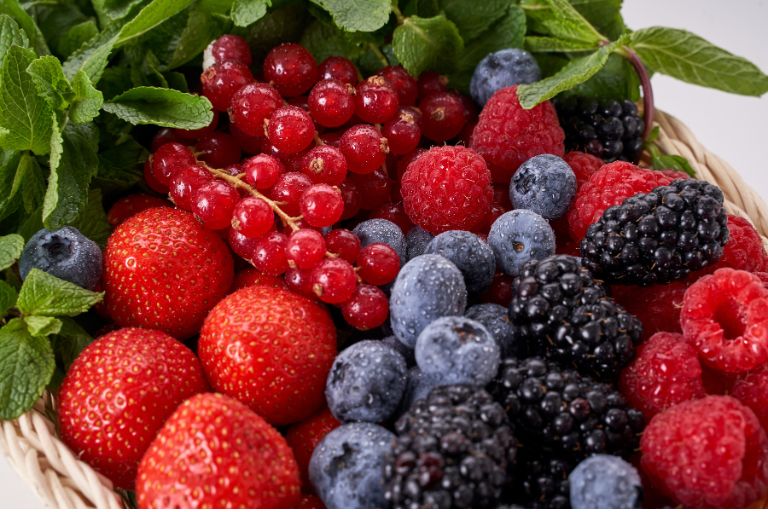
Temperature and Humidity Control
Maintaining optimal temperature and humidity levels in the greenhouse environment is critical to the health, growth and productivity of containerised berry plants. By implementing a combination of insulation, ventilation and humidity control strategies, you can create a stable and conducive environment for your plants throughout the year. Below is a closer look at these strategies:
Insulation
– Proper insulation is essential for regulating temperature fluctuations and conserving energy in the garage. Consider insulating garage walls, ceilings and doors to minimise heat loss during colder months and heat gain during hotter months. Common insulation materials include foam board, fibreglass batts and reflective insulation.
– Seal any gaps or cracks in the garage structure to prevent air leakage and drafts. Weather stripping and caulking are effective for sealing gaps around windows, doors and vents. In addition, install insulated garage doors or add insulating panels to existing doors to improve thermal efficiency.
– Also pay attention to the garage floor. If the garage floor is uninsulated, consider adding insulation panels or installing a thermal barrier to minimise heat transfer from the ground.
Ventilation
– Adequate ventilation is essential to maintain good air quality and prevent moisture build-up in the garage. Install vents or exhaust fans to facilitate air circulation and remove stale air. Position vents strategically to promote airflow throughout the room.
– Consider installing a ridge vent or roof vent to allow hot air to escape from the top of the garage, promoting natural convection and reducing heat build-up. In addition, use wall or ceiling fans to improve air circulation, especially during warmer months.
– Open windows or garage doors regularly to let fresh air in and stale air out. Use window fans or box fans to improve cross-ventilation and encourage airflow throughout the garage.
Humidifiers and dehumidifiers
– Use humidifiers to increase humidity levels in the garage during dry periods or in regions with low humidity. Humidifiers add moisture to the air, creating a more favourable environment for berry plants, especially during the winter months when indoor heating can cause the air to become dry and arid.
– Monitor humidity levels regularly with a hygrometer or humidity meter and adjust humidifier settings accordingly to maintain the desired humidity range (ideally between 40% and 60% for most berry plants).
– Conversely, use dehumidifiers to reduce humidity levels in the garage if they exceed optimal ranges or if excess moisture is causing problems such as mould growth or fungal diseases. Dehumidifiers remove moisture from the air, helping to maintain a drier and more comfortable environment.
Temperature control
– Maintain a consistent temperature in the garage by installing a thermostat-controlled heating system or portable heaters. This is particularly important during the colder months when temperatures can drop below optimum levels for berry crops. Set the thermostat to maintain temperatures within the desired range for your specific plants.
– Use insulating blankets or frost blankets to cover berry plants during extreme cold spells or frosty nights to protect them from freezing temperatures. Avoid placing plants near draughts or direct heat sources as sudden temperature changes can stress plants and affect their growth.
– Provide shade for berry plants during hot summer months to prevent overheating and sunburn. Use shade cloth or move plants to shaded areas of the garage to reduce exposure to direct sunlight and minimise heat stress.
Pollination
Addressing the issue of indoor pollination is essential for containerised berry plants as they may not have access to natural pollinators such as bees and other insects. Without adequate pollination, berry plants may fail to produce fruit or have reduced yields. Below are some techniques to address this issue and ensure successful pollination indoors:
Hand pollination
– Hand pollination is a simple and effective method of manually transferring pollen between flowers, mimicking the natural pollination process. Use a small brush, cotton swab or your fingertip to gently transfer pollen from the stamens (male reproductive organs) of one flower to the pistil (female reproductive organ) of another flower.
– For berry plants with several flowers on each inflorescence (cluster of flowers), gently shake the inflorescence to dislodge pollen and facilitate self-pollination. Repeat this several times a week during the flowering period to ensure thorough pollination and maximise fruit set.
Introduce pollinator-friendly plants
– Incorporating pollinator-friendly plants into the indoor garden can attract beneficial insects such as bees, butterflies and hoverflies, which can help with pollination. Choose flowering plants with open, accessible flowers that provide nectar and pollen as food sources for pollinators.
– Choose pollinator-friendly plants that bloom at the same time as your berry plants to ensure overlapping flowering periods and maximise pollination opportunities. Examples of pollinator-friendly plants include lavender, borage, marigolds and herbs such as basil and thyme.
– Place pollinator-friendly plants near berry plants to attract pollinators and encourage them to visit and pollinate the flowers. Make sure these companion plants have the right growing conditions, including adequate sunlight, water and soil nutrients.
Introduce pollinator insects
– In some cases, it may be possible to introduce pollinator insects such as mason bees or bumblebees to the indoor garden to help with pollination. Mason bees in particular are efficient pollinators and can be kept in small nest boxes or tubes near berry plants.
– Purchase mason bee cocoons or nesting material from reputable suppliers and provide suitable nesting sites within the indoor garden. Ensure that the nest sites are protected from pests and predators and provide suitable conditions for bee activity.
– Monitor bee activity and provide supplementary food sources such as sugar water or floral resources to support the health and longevity of the pollinator population. Be aware of the potential risks associated with introducing live insects indoors and take appropriate precautions to prevent escape or unwanted consequences.
Artificial pollination techniques
– In cases where natural pollination methods are not feasible or effective, consider using alternative artificial pollination techniques such as vibration or air-assisted pollination. Use a small vibrating device or electric toothbrush to gently shake flower clusters and dislodge pollen for self-pollination.
– Air-assisted pollination techniques involve blowing air over flower clusters to disperse pollen and facilitate pollination. Use a handheld fan or compressed air duster to create an airflow around the flowers to ensure thorough pollen transfer and fruit set.
Pest and Disease Management
Preventing and managing common pests and diseases is essential to maintaining the health and vitality of container-grown berry plants indoors. Below are some tips and strategies to help you effectively prevent and manage pests and diseases:
Regular inspection
– Inspect your berry plants regularly for signs of pest infestation such as chewed leaves, holes, webs or sticky residue. Check the undersides of leaves and along stems for signs of insect activity.
– Look for symptoms of common diseases such as leaf spot, powdery mildew or fungal infections. Early detection allows for prompt intervention and reduces the risk of widespread damage.
Cultural practices
– Practice good sanitation by removing fallen leaves, debris and dead plant material from the soil surface and around the base of plants. This will reduce hiding places for pests and prevent the accumulation of fungal spores and pathogens.
– Avoid overcrowding plants in containers, as crowding can promote the spread of disease and make it easier for pests to attack multiple plants. Allow adequate space between plants to promote airflow and reduce humidity.
– Use clean, sterile potting mix and containers when planting new berry plants to minimise the introduction of soil-borne pathogens and pests. Avoid using garden soil, which may contain weed seeds, pathogens and pests.
Natural remedies
– Use natural remedies and homemade insecticidal sprays to control pests without resorting to harsh chemicals. Solutions made from ingredients such as neem oil, insecticidal soap, garlic, chilli pepper or horticultural oil can effectively deter pests such as aphids, spider mites and whiteflies.
– Use natural fungicides such as copper-based sprays or potassium bicarbonate to control fungal diseases such as powdery mildew or botrytis. These treatments help suppress fungal growth and protect plants from infection.
– Introduce beneficial insects such as ladybugs, lacewings, predatory mites or parasitic wasps to the indoor garden to naturally control pest populations. These beneficial insects prey on common garden pests and help maintain a healthy balance within the ecosystem.
Integrated Pest Management (IPM)
– Implement an integrated pest management (IPM) approach that combines multiple strategies to effectively prevent and manage pests and diseases. This holistic approach focuses on cultural, mechanical, biological and chemical control methods tailored to specific pest and disease problems.
– Use physical barriers, such as row covers or netting, to protect berry crops from pest damage while allowing air and sunlight to pass through. This is particularly useful for excluding pests such as birds, rodents or larger insects.
– Rotate crops regularly to prevent the build-up of pest populations and reduce the risk of soil-borne diseases. Avoid planting the same crop in the same container or location year after year to disrupt pest life cycles and minimise disease pressure.
Monitor and adjust
Continually monitor the effectiveness of pest and disease management strategies and adjust as needed based on observations and changing conditions. Keep detailed records of pest and disease activity, treatment applications and crop responses to track progress and make informed decisions.
Pruning and Maintenance
Pruning, fertilising and general maintenance are essential tasks to promote the growth, productivity and overall health of container-grown berry plants indoors. Below you’ll find a comprehensive guide to these key aspects of containerised berry plant care:
Pruning
Pruning berry plants is necessary to maintain their shape, encourage vigorous growth and maximise fruit production. Here are some general pruning guidelines for common types of berry plants:
Strawberries – Remove old, dead leaves and runners to promote airflow and prevent disease. Trim back excess foliage to allow sunlight to reach the centre of the plant. Pinch off any flowers that appear during the first growing season to divert energy into establishing a strong root system.
Blueberries – Prune out dead, diseased or crossing branches to improve air circulation and light penetration. Thin out overcrowded branches to maintain an open canopy and encourage fruiting. Remove low-growing branches to encourage upward growth and improve access for harvesting.
Raspberries and blackberries – Prune out spent canes after fruiting to encourage the growth of new canes. Thin out overcrowded canes to improve airflow and light penetration. Train canes on a trellis or support system to prevent sprawl and make harvesting easier.
Fertilising
– Containerised berry plants require regular fertilisation to replenish nutrients lost from the soil over time. Use a balanced fertiliser formulated for fruit-bearing plants, such as a 10-10-10 or 20-20-20 mix, and follow the manufacturer’s recommendations for application rates.
– Apply fertiliser during the growing season, starting in early spring when new growth appears and continuing every 4-6 weeks until late summer. Avoid fertilising during the dormant winter months when plant growth is minimal.
– Alternatively, use organic fertilisers such as compost, aged manure or fish emulsion to feed berry plants. Apply organic fertiliser as a top dressing around the base of the plants, then water thoroughly to encourage nutrient uptake.
Monitor for signs of stress or disease
– Monitor containerised berry plants regularly for signs of stress, disease or pest infestation. Common signs of stress include wilting, yellowing leaves, stunted growth or drooping foliage.
– Inspect plants closely for symptoms of common diseases such as powdery mildew, leaf spot or root rot. Treat affected plants immediately with appropriate fungicides or natural remedies to prevent the disease from spreading to healthy plants.
– Look for signs of pest infestation such as chewed leaves, holes, webbing or insect activity. Use integrated pest management (IPM) strategies to control pests naturally and minimise damage to berry plants.
– Provide optimal growing conditions for containerised berry plants, including adequate sunlight, proper watering, well-drained soil and appropriate temperatures. Address any environmental factors that may contribute to plant stress, such as excessive heat, cold drafts, or fluctuations in humidity.
General maintenance
– Keep containerised berry plants well watered, ensuring that the soil remains moist but not soggy. Water plants thoroughly when the top inch of soil feels dry to the touch and adjust watering frequency according to environmental conditions and plant needs.
– Mulch the soil surface around berry plants with organic material such as straw, shredded leaves or pine bark to conserve moisture, suppress weeds and regulate soil temperature.
– Inspect containers regularly for signs of wear or damage, such as cracks, leaks or root-bound plants. If necessary, re-pot plants into larger containers to allow for root growth and to prevent overcrowding.
Harvesting and Enjoying Your Berries
Harvesting, preserving and enjoying the fruits of your labour is one of the most rewarding aspects of growing berries in containers indoors. Below you’ll find advice on when and how to pick berries, as well as tips on preserving and enjoying your freshly harvested crop:
When to harvest
Harvest times vary depending on the type of berry plant and the specific variety you’re growing. Here are some general guidelines on when to harvest common berry crops:
Strawberries – Harvest when the berries are fully ripe and have developed their characteristic colour (usually red, but can vary depending on the variety). The berries should be firm, plump and evenly coloured. Gently twist or cut the berries from the stalk to avoid damaging the plant.
Blueberries – Harvest when the berries are a deep, dark blue colour and firm to the touch. Blueberries do not continue to ripen after picking, so wait until they are fully ripe before harvesting. Simply pluck the berries from the stem or gently shake the bush to remove ripe berries.
Raspberries and blackberries – Harvest when the berries are fully ripe and easily detach from the plant with a gentle tug. Raspberries should be firm, bright in colour and easily detach from the container. Blackberries should be shiny, firm and fully black in colour.
How to harvest
– When harvesting the berries, handle them gently to avoid bruising or damaging the delicate fruit. Use clean, sharp scissors or pruning shears to cut the berries from the stem, or simply pluck them by hand.
– Take care not to bruise or stack the berries as this can cause bruising and spoilage. Place harvested berries in shallow containers or baskets lined with paper towels to cushion and protect them during transport.
Preserving berries
– If you have a surplus of fresh berries, consider preserving them for year-round enjoyment. Common methods of preserving berries include freezing, canning and making jams, jellies or preserves.
– To freeze berries, spread them out in a single layer on a baking sheet and freeze until firm. Transfer frozen berries to airtight containers or freezer bags and store in the freezer for up to six months. Frozen berries can be used in smoothies, baked goods or as toppings for yoghurt and cereal.
– When canning, follow tested recipes and proper canning procedures to safely preserve berries in jars. Canned berries can be stored in a cool, dark place for up to a year and used in a variety of recipes.
– Making jams, jellies or preserves is another delicious way to preserve berries. Cook the berries with sugar and pectin, then pour the mixture into sterilised jars and process according to canning guidelines. Homemade jams and jellies make great gifts and are perfect for spreading on toast or biscuits.
Enjoy fresh berries
– There’s nothing quite like the taste of freshly picked berries! Enjoy your freshly picked berries on their own as a healthy snack or incorporate them into your favourite recipes.
– Add fresh berries to salads, cereals, oatmeal or yoghurt for a burst of flavour and nutritional benefits. Mix them into pancake or waffle batter, or use them as a topping for ice cream, cheesecake or pudding.
– Get creative in the kitchen and experiment with different flavour combinations and recipes using fresh berries. From berry smoothies and salads to pies, tarts and cobblers, the possibilities are endless!
Growing berries in containers indoors can be a rewarding and fulfilling experience, offering the opportunity to enjoy the fresh taste of home-grown fruit all year round. By following the comprehensive guidelines in this guide, you can successfully grow healthy, productive berry plants in the controlled environment of your home or garage.
From selecting the right varieties and containers, to creating optimal growing conditions and implementing proper care techniques such as pruning, fertilising and pest control, each step plays a crucial role in the success of your indoor berry garden. With careful attention to detail and regular maintenance, you can promote vigorous growth, abundant fruit production and overall plant health.
Harvesting your own berries is a rewarding moment, signalling the culmination of your efforts and the beginning of a delicious culinary journey. Whether eaten fresh from the plant, preserved for later use, or incorporated into a variety of recipes, homegrown berries offer unparalleled flavour and nutritional benefits.
